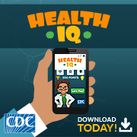|
|||||||||||||||||||||||||||||||||||||||||||||||||||||||||||||||||||||||||||||||||||||||||||||||||||||||||

CDC Learning Connection: What's New For November 2015 11/02/2015
Having trouble viewing this email? View it as a Web page.

CDC Learning Connection
Where the public health community goes to learn
November 2015
Visit www.cdc.gov/learning
The CDC Learning Connection (CDC LC) connects the public health and healthcare workforce to quality public health training opportunities and educational tools. Through website features, social media, and this e-newsletter, CDC LC is the ideal place to stay abreast of new public health learning opportunities, including many that offer free continuing education (CE). Tell your colleagues about CDC Learning Connection and encourage them to sign up to receive these monthly e-newsletters.
In the Spotlight: New Public Health 101 E-Learning Courses

CDC’s Public Health 101 Series provides an introduction to sciences essential to public health practice. Earlier this year, CDC provided customizable slide presentations on these diverse topics: epidemiology, public health informatics, surveillance, health economics, and public health laboratory science. Interactive e-learning products are now available for each of these essential public health topic areas. Learn more about the Public Health 101 Series and access the new e-learning courses today!
Learn More
Now Accepting Applications: 2016 E-Learning Institute

Have you been asked to develop online training products for your organization but aren’t sure where to start? If so, you are invited to apply to the 2016 E-Learning Institute. This unique “training in place” fellowship, offered by the CDC in partnership with the Public Health Foundation, will empower you to create quality e-learning products while you continue to work. As a fellow during the 4 month curriculum, you will take part in online learning opportunities, collaborate with peers, receive mentoring support from e-learning experts, and ultimately create an online training product for your organization. Participants will travel twice to the CDC in Atlanta, GA to attend a kick-off orientation and a final showcase event. Space is limited, so apply today to be considered for this exceptional learning opportunity. CDC is accepting applications now through November 13, 2015.
Learn More
TRAIN: One Million Registered Learners

On October 29, 2015, the national TRAIN learning network reached one million registered learners. TRAIN was launched in 2003 by the Public Health Foundation as a platform for health agencies to manage, disseminate, and share workforce trainings. Today, 25 states and 3 federal agencies (CDC, MRC and VHA) are part of this network and thousands of other government agencies, universities, and organizations contribute to trainings found on TRAIN. Health professionals can register as learners at no cost, and access thousands of trainings - the majority of which are free. If you are not one of the million strong registered learners, visit CDC TRAIN today and access courses to meet your professional development needs.
Learn More
CDC E-Learning Course on Diabetes

In honor of American Diabetes Month, CDC Learning Connection features a new web-based course for clinicians, “New Beginnings: Managing the Emotional Impact of Diabetes.” This series of audio programs from the National Diabetes Education Program) focuses on how you can help your patients learn to manage the emotional impact of diabetes by building strong relationships with family, friends, and health care providers. Coping with the ups and downs of living with a chronic disease is an area of care that is often overlooked, but is essential to helping patients take action to manage their diabetes. Take the course and earn free CE.
Learn More
CDC Health IQ App

Do you know the minimum SPF needed to protect yourself from the sun's harmful rays? Or how many seconds you should wash your hands to kill germs? Test your health IQ to see how your health skills stack up. Choose from three levels of difficulty or be surprised by selecting a Random mix. Each quiz delivers a mix of 10 questions. Correctly answer as many of the 10 questions as quickly as possible with the hopes of earning bonuses like A+ Student, Public Health Nerd, and Einstein or score poorly and earn the Hot Mess achievement! New questions will be added frequently. Play again and again and try to beat your highest score!
Learn More
National Diabetes Month: Time to Take Charge 11/02/2015
Having trouble viewing this email? View it as a Web page.

November 2, 2015
National Diabetes Month: Time to Take Charge

November is National Diabetes Month, a perfect time to remember that if you have diabetes, what you do every day has a big impact on your health and quality of life. Good blood sugar control can help prevent or delay complications, and early detection and treatment of complications can keep them from getting worse.
To help take charge of your diabetes, take these actions every day:
- Follow a healthy eating plan by eating more fruits and vegetables and less sugar and salt.
- Get physically active – 10 to 20 minutes a day is better than an hour once a week.
- Take diabetes medicine as prescribed by your doctor.
- Check your blood sugar regularly to understand and track how food, activity, and medicine affect your blood sugar levels.
And make sure you know your diabetes ABCs. By managing your ABCs, you can help lower your risk for heart attack, stroke, and other complications:
- A – the AIC test, which measures average blood sugar over 2 to 3 months
- B – blood pressure, the force of blood flow inside blood vessels
- C – cholesterol, a group of blood fats that affect the risk of heart attack or stroke
- s – stop smoking or don’t start
Living with diabetes is challenging, but taking good care of yourself makes a big difference in feeling your best and being your healthiest now and in the future.
For more information:
- Take Charge of Your Diabetes [PDF – 0.99 MB]
- Caring for Yourself with Diabetes
- Healthy Eating and Great Recipes
- Prevent Complications

Why Measure Health Literacy Skills? 11/02/2015
Having trouble viewing this email? View it as a Web page.
View the Latest PHIL Images From This Week.
Centers for Disease Control
and PreventionSaving Lives. Protecting People. TM www.cdc.gov Why Measure Health Literacy Skills?
Assessing people’s health literacy skills can be a critical step when designing a research project or choosing an effective intervention. The ability to create or choose oral, written, or graphic health messages that match your audience’s understanding comes from knowing about their health literacy skills. Better understanding of health materials can lead to informed decision making and potential changes in health behavior.
The “Measures of People's Skills and Experiences” section of CDC’s Health Literacy website offers links to tools and research that explain options for measuring health literacy skills.
The Health Literacy Tool Shed is a new online database that contains information about measures, including their psychometric properties, based on a review of the peer-reviewed literature. The project was sponsored by the U.S. National Library of Medicine.
Get more information about this tool and others by visiting our Measures of People's Skills and Experiences webpage.
MMWR Vol. 64 / Early Release 11/03/2015
MMWR Early Release
Vol. 64, Early Release
November 3, 2015
In this report
Vital Signs: Multistate Foodborne Outbreaks — United States, 2010–2014
Samuel J. Crowe, PhD, Barbara E. Mahon, MD, Antonio R. Vieira, PhD, et al.
MMWR Morb Mortal Wkly Rep 2015;64(Early Release):1-5
Millions of U.S. residents become ill from foodborne pathogens each year, and substantial percentages of hospitalizations and deaths come from multistate foodborne outbreaks. This report analyzes data from CDC’s Foodborne Disease Outbreak Surveillance System to describe multistate foodborne outbreaks that occurred in the United States during 2010–2014.
MMWR Masthead
Department of Health and Human Services
Centers for Disease Control and Prevention
Stopping Multistate Foodborne Outbreaks 11/03/2015

November 3, 2015 | Stopping Multistate Foodborne Outbreaks
Stopping Multistate Foodborne Outbreaks
CDC Report: Working Together to Stop Outbreaks and Make Food Safer
Multistate outbreaks cause more than half of all deaths in foodborne disease outbreaks despite accounting for only a tiny fraction (3 percent) of reported outbreaks in the United States, according to a new Vital Signs report released today. Recent outbreaks of foodborne illness linked to tainted cucumbers, ice cream and soft cheeses show the devastating consequences when food is contaminated with dangerous germs before it reaches a restaurant or home kitchen.

Report Highlights
Highlights from the report on multistate foodborne outbreaks during 2010-2014 include:
- An average of 24 multistate outbreaks occurred each year, involving two to 37 states.
- Salmonella accounted for the most illnesses and hospitalizations and was the cause of the three largest outbreaks, which were traced to eggs, chicken and raw ground tuna.
- Listeria caused the most deaths, largely due to an outbreak caused by contaminated cantaloupe in 2011 that killed 33 people.
- Imported foods accounted for 18 of the 120 reported outbreaks. Food imported from Mexico was the leading source in these outbreaks, followed by food imported from Turkey.
Food Industries and the Government Can Work Together to Stop Outbreaks and Make Food Safer

The Vital Signs report recommends that local, state, and national health agencies work closely with food industries to understand how their foods are produced and distributed to speed multistate outbreak investigations. These investigations can reveal fixable problems that resulted in food becoming contaminated and lessons learned that can help strengthen food safety.
The report highlights the need for food industries to play a larger role in improving food safety by following best practices for growing, processing, and shipping foods. In addition, food industries can help stop outbreaks and lessen their impact by keeping detailed records to allow faster tracing of foods from source to destination, by using store loyalty cards to help identify what foods made people sick, and by notifying customers of food recalls.

About Vital Signs
CDC’s Vital Signs report addresses a single, important public health topic each month. The November edition focuses on multistate outbreaks of foodborne disease. These outbreaks frequently cause serious illness in people. In collaboration with our federal and state public health partners, we are finding more of these outbreaks because of improvements in disease surveillance and testing. To stop outbreaks and make food safer, food industries and government must work together to prevent them.
Visit the Safer Food Saves Lives Vital Signs Web page to find the research article from the Morbidity and Mortality Report (MMWR), fact sheet, and other materials.
View archived issues of CDC and Food Safety.
CDC Press Release: Multistate foodborne disease outbreaks sicken thousands, highlight need for action 11/03/2015 Press Release
Embargoed until 1:00 PM ET
Tuesday, November 3, 2015
Contact: CDC Media Relations
(404) 639-3286
Multistate foodborne disease outbreaks sicken thousands, highlight need for action
Government and food industries can work together to make food safer
Multistate outbreaks cause more than half of all deaths in foodborne disease outbreaks despite accounting for only a tiny fraction (3 percent) of reported outbreaks in the United States, according to a new Vital Signs report released today by the Centers for Disease Control and Prevention (CDC).
The leading causes of multistate outbreaks – Salmonella, E. coli, and Listeria – are more dangerous than the leading causes of single-state outbreaks. These three germs, which cause 91 percent of multistate outbreaks, can contaminate widely distributed foods, such as vegetables, beef, chicken and fresh fruits, and end up sickening people in many states.
“Americans should not have to worry about getting sick from the food they eat,” said CDC Director Tom Frieden, M.D., M.P.H. “Top-notch epidemiology and new gene sequencing tools are helping us quickly track down the source of foodborne outbreaks – and together with our national partners we are working with the food industry to prevent them from happening in the first place.”
The Vital Signs report analyzed data from CDC’s Foodborne Disease Outbreak Surveillance System during 2010-2014. CDC scientists compared the number of illnesses, hospitalizations and deaths from outbreaks in two or more states with those from outbreaks that occurred in a single state. They found that the 120 multistate outbreaks during the five-year study period were responsible for 11 percent of all foodborne outbreak illnesses, 34 percent of hospitalizations and 56 percent of deaths. An average of 24 multistate outbreaks occurred each year, involving two to 37 states.
###
U.S. Department of Health and Human Services
CDC works 24/7 protecting America’s health, safety and security. Whether diseases start at home or abroad, are curable or preventable, chronic or acute, stem from human error or deliberate attack, CDC is committed to respond to America’s most pressing health challenges.
Preventive health care can help Americans stay healthier throughout their lives. Those enrolled in health insurance coverage can use the “Roadmap to Better Care and a Healthier You” (English and Spanish) to learn about their benefits, including how to connect to primary care and the preventive services that are right for them, so that they can live a long and healthy life.
SAVE THE DATE - CDC Vital Signs Town Hall Teleconference November 10, 2015, 2:00–3:00pm (EDT) 11/03/2015
Vital Signs Town Hall Teleconference
Join us on November 10, 2015
Working Together to Stop Multistate Foodborne Outbreaks

Join CDC subject matter experts and other public health professionals for a town hall teleconference on
Tuesday, November 10, 2015
2:00–3:00 pm (EDT)Add event to Outlook
Invitation and more information to follow.Dial in (USA only): 800-857-0764
Passcode: 795-4413Overview
The Vital Signs report is available on CDC's website the first Tuesday of every month.
Speakers and topics are subject to change. Always check the Vital Signs Town Hall Teleconference website to get the most up-to-date information.
Each month’s teleconference provides a forum for state, tribal, local and territorial health, policy, and communication officials to broaden the conversation, build momentum, and ensure active implementation of evidence-based, effective programs within the public health areas covered by Vital Signs.CDC Press Release: CDC challenge: Find better ways to prevent healthcare-associated blood clots 11/03/2015 Press Release
For Immediate Release
Tuesday, November 3, 2015
Contact: CDC Media Relations
(404) 639-3286
CDC challenge: Find better ways to prevent healthcare-associated blood clots
To identify best practices and to increase use of strategies to prevent healthcare-associated blood clots, the Centers for Disease Control and Prevention today launched a challenge designed to find, honor and recognize hospitals, multi-hospital systems, hospital networks, and managed care organizations that have implemented innovative and effective prevention strategies or interventions.
Venous thromboembolism (VTE), blood clots occurring as deep vein thrombosis, pulmonary embolism, or both, is an important and growing public health concern. They affect as many as 900,000 Americans each year, leading to approximately 100,000 premature deaths per year. About half of all blood clots happen after a recent hospital stay or surgery. In patients with cancer, blood clots are a leading cause of death after the cancer itself.
Preventing healthcare-associated venous thromboembolism (HA-VTE) is a national hospital safety priority. Some estimates show that as many as 70 percent of HA-VTEs are preventable, yet fewer than half of hospital patients receive appropriate prevention including the information they need and items such as anticoagulants and compression devices in accordance with accepted evidence-based guidelines.
“Doctors and nurses in hospitals and other healthcare settings can save lives by implementing the best practices discovered through this challenge,” said CDC Director Tom Frieden, M.D., M.P.H. “ýTell us about what you are doing and what’s helping prevent blood clots, so we can advance science and save lives together.”
###
U.S. Department of Health and Human Services
CDC works 24/7 protecting America’s health, safety and security. Whether diseases start at home or abroad, are curable or preventable, chronic or acute, stem from human error or deliberate attack, CDC is committed to respond to America’s most pressing health challenges.
The CDC has reached 1 million email subscribers. Thank you for your support.
Modify/Update Subscriber Preferences or Unsubscribe | Learn about CDC Updates
Questions or problems? Please contact [log in to unmask].





This email was sent to [log in to unmask] using GovDelivery,on behalf of: Centers for Disease Control and Prevention • 1600 Clifton Rd • Atlanta, GA 30333 • 1-800-CDC-INFO (800-232-4636)
To unsubscribe from the NFS-L list, click the following link:
&*TICKET_URL(NFS-L,SIGNOFF);